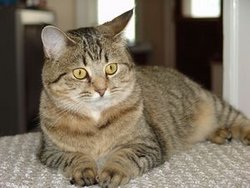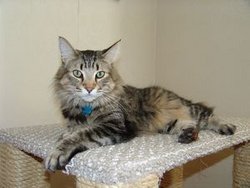

Custom Search
|
| Pixie-Bob |
|---|
 |
| Short-haired Pixie-Bob |
| Country of origin |
| United States |
| Breed standards (external links) |
| CCA, TICA |
The Pixie-Bob is a breed of cat. According to legend, it is a hybrid offspring of a domestic cat and a bobcat, but DNA testing has failed to show that Pixie-Bobs are directly related to bobcats. Directly related would indicate identical Y-Chromosomes or limited Marker match testing. Therefore, Pixie-Bob are legally designated as domestic cats, even if they might have Bobcat heritage. The Pixie-Bob has a large body with big feet, and usually a short, bobbed tail and a gentle personality. Most Pixie-Bobs are short-haired, with the less common long-hair Pixie-Bob more closely resembling a bobcat. Its markings resemble those of a bobcat, with spots, stripes and swirls. This breed is currently the only one accepted by any major club to allow polydactyls, cats having more than the usual number on toes on each foot (five for the front paws, four for the back). Adult males weigh 1622 lbs (710 kg), and females weigh 812 lbs (3.55.5 kg).
 Long-haired Pixie-Bob
Long-haired Pixie-Bob
Pixie-Bobs are approximately 50% larger then most domestic cats (which weigh 5.516 lbs or 2.57 kg). Most Pixie-Bobs have black fur and skin on the bottom of their paws, tipped ears, heavy ear hair, black lips, and white fur around the eyes but with black eye skin. Their chins have white fur, but often have black skin under the white fur. Some of their whiskers change from Black (root - about 25%) to White (to the tip - about 75% of the whisker).Tiger-like fur pattern, but often have reddish tones mixed in. Stomach is often reddish-gold in color with some ticking (broken stripes). Most are short-haired, but some are long-haired. Eyes are almond shaped and tilted. Eyes are blue when kittens, then change to green, and finally to gold when several months old (some don't change completely to Gold, but have a Gold with a green tint). Tails can be non-existent (rumpy), or 2-4 inches (desired - TICA required), or long tails (Pixie was a long tail). The head is usually-pear shaped. The head and tail are considered the important characteristics. They grow for 3 years instead of 1 year like most domestic cats.
They are highly intelligent, social, active (but not hyper-active), bold, courageous, and enjoy playing with other animals. Known for their chirps, chatters, and growls. Some Pixie-Bobs can be highly sociable around their owners and strangers, while others are highly social around their owners, but shy around strangers. Almost all Pixie-Bobs like to be in the same room as their owners, and will follow their owners around the house. Other personality characteristics, are head bunting; Chirping language (communicating with owners and other Pixie-Bobs) by different chirps; Most don't meow often, and some don't meow at all; Ball fetching and playing; Some can be walked on a leash; Highly intelligent (Dog analogy would be intelligent like a Golden Retriever) and capable of understanding some human words and phrases.
Carol Ann Brewer is credited with the creation of the Pixie-Bob breed in the mid 1980s. She took two different Legend cats , believed to be the result of natural breeding between bobcats and domestic cats, and bred them to create the first Pixie-Bob domestic cat. This first cat was named Pixie, hence the name Pixie-Bob. DNA testing shows that Pixie-Bob cats are domestic, and not wild or an exotic hybrid, as the early advertisements had alleged, but many are still unsure if this is entirely true. Pixie-Bob cats share many of the physical and personality characteristics of bobcats, except they are approximately half the size, and do not have some of the wild characteristics. Pixie-Bobs are a paradox. They look and act very much like Bobcats, but are legally defined as domestic cats. For a cat to be considered a Certified TICA Pixie-Bob cats, they cannot be bred with bobcats, and one of their parents must be traced back to Pixie the cat.
While Pixie-Bobs are considered to be domestic cats, Pixie-Bobs have been used to create other exotic hybrids such as the Desert Lynx and Jungle Bobs. Pixie-Bobs are legal in all 50 states without a license, and are legally considered domestic cats, despite the fact that they appear to have a bobcat heritage.
Cats, made by MultiMedia | Free content and software
This guide is licensed under the GNU Free Documentation License. It uses material from the Wikipedia.